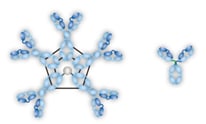Antibodies
IgM Antibody
immunoglobulin M(IgM) Antibody Overview
IgM Antibody Key Features and Comparison with IgG Antibody(IgM vs IgG)

Figure 1: IgM pentamer and IgG monomer structures shown above.
| Feature | IgM Antibody | IgG Antibody |
|---|---|---|
| Size | 970 kDa | 150 kDa |
| Immunoglobulin Structure | Pentameric (monomeric as B-cell receptor) |
Monomer |
| Location | Lymph and Blood | Blood, Lymph, Can Cross Placenta |
| Binding Sites | 10 | 2 |
| Immune Function |
|
|
IgM Antibody Functions and its Role in Disease
During infection, innate or “natural immunity” is provided by poly-reactive IgM antibody made by (B1a) B cells. IgM antibody acts to quickly recognize and initiate an immune response by directly neutralizing pathogens or clearing novel antigens. The three components of the IgM antibody-mediated immune response are activation of complement (C1qR and Fcα/µR), recruitment of phagocytic cells, and opsonization. Current research suggests that B1b B cells which make IgM antibodies may provide memory to certain pathogens and support T-cell independent immune responses. IgM antibody also acts as an educator of the immune system by transporting antigens to lymph tissues where memory is induced. Read more »
IgM Antibody Applications and Advancements
The IgM class of antibodies recognizes a large variety of pathogenic antigens and is highly active in cytotoxic and cytolytic reactions due to its superior activation of the complement system. IgM antibody has applications in Antibody Drug Discovery. Just a few reasons why IgM antibody can be an attractive therapeutic are listed below.
- IgM antibody can make a good biologic against cancer owing to its strong avidity as well as complement fixation property.
- For certain targets, particularly those such as glycol-epitopes on cancer cells, an IgM antibody might be the best approach.
- An IgM antibody might also be useful as a vaccine adjuvant, acting as soluble toll-like receptors through the formation of immune complexes with antigen.
- It has been suggested to use IgMs as preventive vaccine.
- The innate ability of IgM to mediate autoimmunity can be utilized to ameliorate graft rejections during transplantation procedures.
- The inflammatory control IgM antibody provides systemic exposure to self antigens could be harnessed to treat arthritis.
Recent advancements have made IgM antibody amenable to manipulation that allows further tuning of its effector function to meet the above therapeutic needs. There are several requirements for IgM antibodies to be considered as a potential standard platform, including in vitro optimization, recombinant production, and purification. IgM antibody variable chains have been manipulated using phage display technology in vitro to optimize IgM therapeutic antibody candidates. Their recombinant yields in cell culture have been improved and methods for purification have been optimized. Based on these advances an IgM therapeutics platform can be built.
IgM Antibody Production and Purification
As opposed to all other forms of immunoglobulins, IgM antibody not does not bind well to protein A or protein G for purification. It is also adversely affected by traditional elution techniques. IgM antibody stability and narrow solubility range proved confounding for purification techniques until recently. IgM antibody size serves well for size exclusion purification, but is speed-limiting at larger volumes. The advancement in purification of IgM monoclonal antibodies relies on the fact that they typically have a high charge, allowing them to be purified by ion exchange. Hydroxyapatite, a naturally occurring mineral, binds IgM antibodies under physiological pH conditions offering another means of separation.
